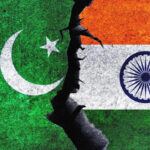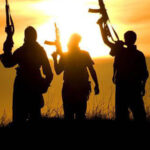The hard reality, especially for India, is that the future of counter terrorism cooperation is going to be less cooperative, with counter-terror regimes rendered toothless
India’s decision to host the special session of the United Nations Security Council’s Counter-Terrorism Committee (UNSC-CTC) last month — held in Mumbai and New Delhi, it focused on new and emerging technologies — is one of a number of events planned by the Government to give its counter-terror diplomacy a greater push. Later this month, New Delhi will host the third edition of the “No Money For Terror” (NMFT) conference that will look at tackling future modes of terror financing. And in December, when India takes over the United Nations Security Council Presidency for the last time before its two-year term in the Council ends, India will chair a special briefing on the “Global Counter Terrorism Architecture”, looking at the challenges ahead.
While the focus is on the future of the fight against terrorism, it is important to look at some of the challenges that already exist, especially when the world’s attention is consumed by the war in Europe, dealing with the aftermath of COVID-19, and global economic recession.
GWOT – built on an unequal campaign
The first challenge is that the “Global War On Terrorism” (GWOT), as it was conceived by a post-9/11 United States is over with the last chapter written last year, as the United States negotiated with the Taliban, and then withdrew from Afghanistan. GWOT itself was built on an unequal campaign — when India had asked for similar help to deal with the IC-814 hijacking (December 1999) less than two years prior to the 9/11 attacks (with evidence now clear that those who the Atal Bihari Vajpayee government was forced to release were all terrorists who went on to help with planning, funding or providing safe havens to the al-Qaeda leadership), its pleas fell on deaf ears in the U.S., the United Kingdom, the United Arab Emirates (UAE), and of course, Pakistan, all of whom were hit by the same terrorists in later years.
Even after GWOT was launched, Pakistan’s role as the U.S.’s ally, and China’s “iron friend” ensured that the UNSC designations of those who threatened India the most, including Masood Azhar and Hafiz Saeed, never mentioned their role in attacks in India. The maximum India received in terms of global cooperation was actually from economic strictures that the Financial Action Task Force (FATF)’s grey list placed on Pakistan — Pakistan was cleared from this in October — indicating that the global appetite to punish Pakistan for terrorism has petered out.
In addition, the weak international reaction to the Taliban’s takeover of Kabul, and its persecution of women and minorities in the country, demonstrate rising fatigue levels in dealing with “another country’s problems”. The hard reality for India is that the future of counter-terrorism cooperation is going to be less cooperative, and counter-terror regimes such as the UNSC Resolutions 1267, 1373, etc. rendered outdated and toothless.
A blur over definition, new technologies
Next, the growing global polarisation over the Russia-Ukraine war is not only shifting the focus from terrorism but is also blurring the lines on what constitutes terrorism. The CTC meeting in Delhi, for example, was disrupted over Russia’s claims that the U.K. helped Ukraine launch drone attacks on Russia’s naval fleet in Sevastopol. The question remains: if drone attacks by Yemeni Houthis on the UAE and Saudi Arabia’s oil infrastructure were condemned as terrorist attacks, why was the line drawn for drone attacks on Russian ships in a port used for loading grain, or a bridge bombing that put so many civilian lives at risk? On the other hand, how will Russia square up the possible recruitment of the former Afghan republic’s National Army Commando Corps into its war in Ukraine? Would not these commandos who once fought Taliban terrorists, now qualify as terrorists themselves?
Away from the battlefield, the polarisation has rendered the body tasked with global peace, paralysed: as the UNSC is unable to pass any meaningful resolutions that are not vetoed by Russia or western members, and China has been able to block as many as five terror designations requested by India and the U.S.
Perhaps the biggest opportunity lost due to the UNSC’s other preoccupations has been the need to move forward on India’s proposal, of 1996, of the Comprehensive Convention on International Terrorism (CCIT). While each conference, including the CTC meeting in Delhi, makes passing the CCIT a goal, very little progress has been made on the actual issues such as the definition of terrorism, concerns over human rights law conflicts, and the old debate on ‘freedom fighter vs terrorist’. Despite several changes in the draft made by India in 2016, consensus for the convention is still elusive.
The next challenge comes from emerging technologies and the weaponisation of a number of different mechanisms for terrorism purposes. Drones are already being used to deliver funds, drugs, weapons, ammunition and even improvised explosive devices. After the COVID-19 pandemic, worries have grown about the use of biowarfare, and Gain-of-Function (GoF) research to mutate viruses and vectors which could be released into targeted populations. In a future that is already here, the use of artificial intelligence (AI) systems and robotic soldiers makes it even easier to perpetrate mass attacks while maintaining anonymity. Terror financing uses bitcoins and cryptocurrency, and terror communications use social media, the dark web and even gaming centres.
The drivers of strife
Unless there is global consensus on regulating the use of these emergent technologies by all responsible states, it will be hard to distinguish their use from those by designated terror entities, or state-sponsored terrorism. Pakistan, Iran and North Korea are the most obvious examples of countries where the establishment has supported terrorist groups carrying out cross-border strikes, drone attacks and cyberwarfare. But what does one make of drone strikes by North Atlantic Treaty Organization countries in Yemen, Syria, Afghanistan, Somalia, where civilians have been killed, or Chinese government-run hackers who disable urban electric grids?
Nor are there any globally accepted norms on how and in what measure one is to respond to those attacks: whether it is the U.S.’s flattening of Afghanistan post-9/11, Pakistan’s aerial strikes on its own populations in Swat and Balochistan, India’s crossing of the UN-monitored Line of Control after the Uri attack (September 2016) and missile strikes on Pakistani territory (Balakot, in February 2019) after the Pulwama suicide bombing (February 2019), or Israel’s relentless bombardment of buildings in Gaza in retaliation for rocket attacks. Without some consensus on what constitutes terror, no war on terrorism can be truly global.
The truth is global inequity, food and energy shortages, climate change and pandemics are going to be the next big drivers of strife and violence in the world, where global stakeholders are at present distracted by territorial disputes and narrow political differences. Terrorist acts of the future will grow more and more lethal, will need fewer people to carry out, and with their sponsors having more and more anonymity. India, as host of these counter-terrorism events, and of the Shanghai Cooperation Organization (SCO) and the next G-20, must stop fighting the “last war” on terrorism, and steer the global narrative towards preparing for the next ones.
‘No consensus’ is derailing counter-terror diplomacy
The hard reality, especially for India, is that the future of counter terrorism cooperation is going to be less cooperative, with counter-terror regimes rendered toothless
India’s decision to host the special session of the United Nations Security Council’s Counter-Terrorism Committee (UNSC-CTC) last month — held in Mumbai and New Delhi, it focused on new and emerging technologies — is one of a number of events planned by the Government to give its counter-terror diplomacy a greater push. Later this month, New Delhi will host the third edition of the “No Money For Terror” (NMFT) conference that will look at tackling future modes of terror financing. And in December, when India takes over the United Nations Security Council Presidency for the last time before its two-year term in the Council ends, India will chair a special briefing on the “Global Counter Terrorism Architecture”, looking at the challenges ahead.
While the focus is on the future of the fight against terrorism, it is important to look at some of the challenges that already exist, especially when the world’s attention is consumed by the war in Europe, dealing with the aftermath of COVID-19, and global economic recession.
GWOT – built on an unequal campaign
The first challenge is that the “Global War On Terrorism” (GWOT), as it was conceived by a post-9/11 United States is over with the last chapter written last year, as the United States negotiated with the Taliban, and then withdrew from Afghanistan. GWOT itself was built on an unequal campaign — when India had asked for similar help to deal with the IC-814 hijacking (December 1999) less than two years prior to the 9/11 attacks (with evidence now clear that those who the Atal Bihari Vajpayee government was forced to release were all terrorists who went on to help with planning, funding or providing safe havens to the al-Qaeda leadership), its pleas fell on deaf ears in the U.S., the United Kingdom, the United Arab Emirates (UAE), and of course, Pakistan, all of whom were hit by the same terrorists in later years.
Even after GWOT was launched, Pakistan’s role as the U.S.’s ally, and China’s “iron friend” ensured that the UNSC designations of those who threatened India the most, including Masood Azhar and Hafiz Saeed, never mentioned their role in attacks in India. The maximum India received in terms of global cooperation was actually from economic strictures that the Financial Action Task Force (FATF)’s grey list placed on Pakistan — Pakistan was cleared from this in October — indicating that the global appetite to punish Pakistan for terrorism has petered out.
In addition, the weak international reaction to the Taliban’s takeover of Kabul, and its persecution of women and minorities in the country, demonstrate rising fatigue levels in dealing with “another country’s problems”. The hard reality for India is that the future of counter-terrorism cooperation is going to be less cooperative, and counter-terror regimes such as the UNSC Resolutions 1267, 1373, etc. rendered outdated and toothless.
A blur over definition, new technologies
Next, the growing global polarisation over the Russia-Ukraine war is not only shifting the focus from terrorism but is also blurring the lines on what constitutes terrorism. The CTC meeting in Delhi, for example, was disrupted over Russia’s claims that the U.K. helped Ukraine launch drone attacks on Russia’s naval fleet in Sevastopol. The question remains: if drone attacks by Yemeni Houthis on the UAE and Saudi Arabia’s oil infrastructure were condemned as terrorist attacks, why was the line drawn for drone attacks on Russian ships in a port used for loading grain, or a bridge bombing that put so many civilian lives at risk? On the other hand, how will Russia square up the possible recruitment of the former Afghan republic’s National Army Commando Corps into its war in Ukraine? Would not these commandos who once fought Taliban terrorists, now qualify as terrorists themselves?
Away from the battlefield, the polarisation has rendered the body tasked with global peace, paralysed: as the UNSC is unable to pass any meaningful resolutions that are not vetoed by Russia or western members, and China has been able to block as many as five terror designations requested by India and the U.S.
Perhaps the biggest opportunity lost due to the UNSC’s other preoccupations has been the need to move forward on India’s proposal, of 1996, of the Comprehensive Convention on International Terrorism (CCIT). While each conference, including the CTC meeting in Delhi, makes passing the CCIT a goal, very little progress has been made on the actual issues such as the definition of terrorism, concerns over human rights law conflicts, and the old debate on ‘freedom fighter vs terrorist’. Despite several changes in the draft made by India in 2016, consensus for the convention is still elusive.
The next challenge comes from emerging technologies and the weaponisation of a number of different mechanisms for terrorism purposes. Drones are already being used to deliver funds, drugs, weapons, ammunition and even improvised explosive devices. After the COVID-19 pandemic, worries have grown about the use of biowarfare, and Gain-of-Function (GoF) research to mutate viruses and vectors which could be released into targeted populations. In a future that is already here, the use of artificial intelligence (AI) systems and robotic soldiers makes it even easier to perpetrate mass attacks while maintaining anonymity. Terror financing uses bitcoins and cryptocurrency, and terror communications use social media, the dark web and even gaming centres.
The drivers of strife
Unless there is global consensus on regulating the use of these emergent technologies by all responsible states, it will be hard to distinguish their use from those by designated terror entities, or state-sponsored terrorism. Pakistan, Iran and North Korea are the most obvious examples of countries where the establishment has supported terrorist groups carrying out cross-border strikes, drone attacks and cyberwarfare. But what does one make of drone strikes by North Atlantic Treaty Organization countries in Yemen, Syria, Afghanistan, Somalia, where civilians have been killed, or Chinese government-run hackers who disable urban electric grids?
Nor are there any globally accepted norms on how and in what measure one is to respond to those attacks: whether it is the U.S.’s flattening of Afghanistan post-9/11, Pakistan’s aerial strikes on its own populations in Swat and Balochistan, India’s crossing of the UN-monitored Line of Control after the Uri attack (September 2016) and missile strikes on Pakistani territory (Balakot, in February 2019) after the Pulwama suicide bombing (February 2019), or Israel’s relentless bombardment of buildings in Gaza in retaliation for rocket attacks. Without some consensus on what constitutes terror, no war on terrorism can be truly global.
The truth is global inequity, food and energy shortages, climate change and pandemics are going to be the next big drivers of strife and violence in the world, where global stakeholders are at present distracted by territorial disputes and narrow political differences. Terrorist acts of the future will grow more and more lethal, will need fewer people to carry out, and with their sponsors having more and more anonymity. India, as host of these counter-terrorism events, and of the Shanghai Cooperation Organization (SCO) and the next G-20, must stop fighting the “last war” on terrorism, and steer the global narrative towards preparing for the next ones.






NO COMMENT